(trematoes) helminths quiz - microbio II (cls 542)
1/60
There's no tags or description
Looks like no tags are added yet.
Name | Mastery | Learn | Test | Matching | Spaced |
|---|
No study sessions yet.
61 Terms
trematodes (general info)
Location: liver, lungs, intestines, or blood stream
Complex life cycle:
First intermediate host is ALWAYS a snail
Second intermediate host, if present, is usually a fish (or plant)
Infective stage
Larval form found in fish or on plants
blood trematodes are known as what?
schistosomes / schistosoma
Medically important species
Of worldwide concern:
Schistosoma mansoni
Schistosoma japonicum
Schistosoma haematobium
schistosomes (general info)
Adult flukes live in veins
Sexual reproduction → two sexes
Looks like a flat roundworm
Think leeches
Large, non-operculated ova with spines
Only has 1 intermediate host: snail
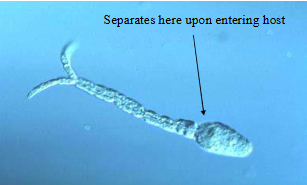
schistosoma life cycle stages
cercariae = infective stage (terror worm)
miracidium = released from egg & infects intermediate host (second pic)
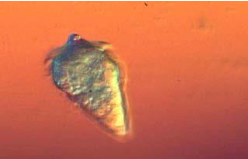
schistosoma life cycle
definitive host passes EMBRYONATED eggs in feces/urine
eggs hatch & release miracidia (1-3 weeks)
miracidia penetrate snail tissue (snail → cercariae takes 4-6 wks)
cercariae released by snail into water (72 hr lifespan)
penetrates skin of definitive host (humans)
cercariae loses tail and becomes schistomulae in human
migrates to portal blood and mature into adults
paired worms migrate to mesenteric venules of bowel or venous plexus of bladder
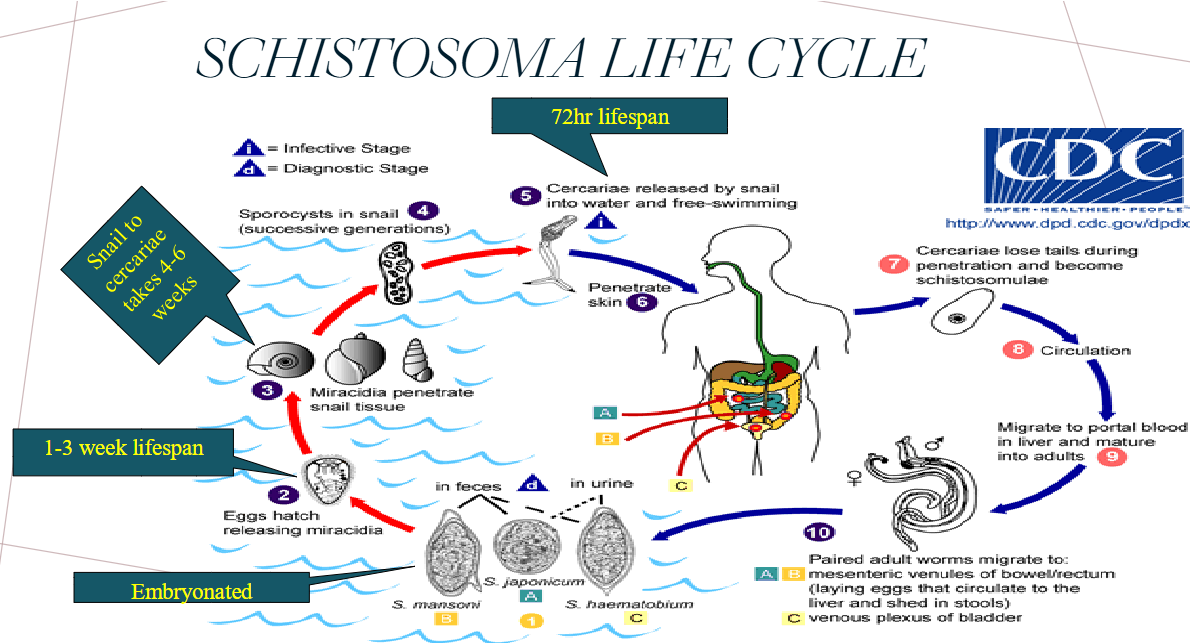
schistomiasis endemic region
200-300 million people infected worldwide
In Egypt, ~20% of the population is infected, some villages have 85% infection rates
Only about 10% of those infected have serious disease
Half of the remaining people have symptoms
In parts of Africa: a rite of male passage into sexual maturity is the development of blood red urine, equated with female menstruation
Result of bladder infection
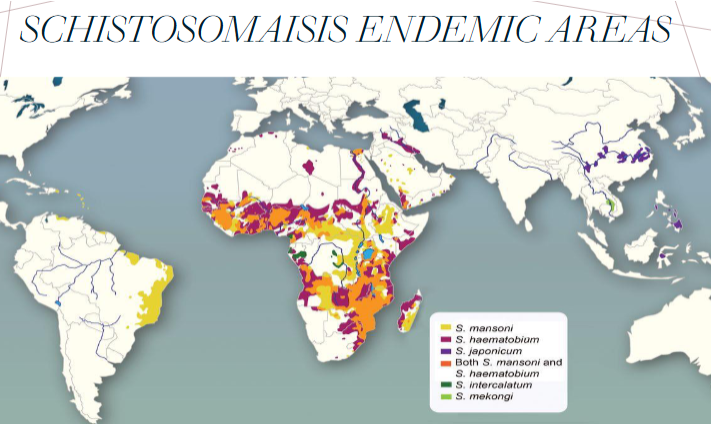
schistosomiasis symptoms/illness
Serum sickness-like illness
Marked peripheral eosinophilia → 30-60%
Circulating immune complexes
Eggs are highly antigenic, adult flukes are not
Acute symptoms resolve over several weeks
Bloody diarrhea, cramping, mimics appendicitis
Adults schistosomes live for years; they coat themselves with host antigens
Chronic/later stages:
Enlargement of liver and spleen, bulging of abdomen, emaciation
schistosoma mansoni
aka Manson’s blood fluke
animal reservoirs: water buffalo
Lives in portal veins of the intestines and liver
Causes Bilharziasis
AKA hepatosplenomegaly
Stunted growth in children
Abdominal swelling due to liver enlargement
schistosoma mansoni eggs
diagnostic stage
very large, 116-180 x 45-58 um
Thin, smooth shell
Indistinct operculum
Prominent lateral spine
Embryonated when passed
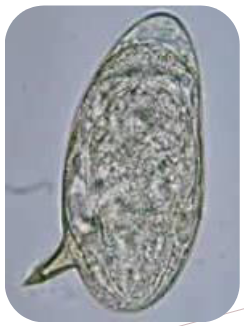
schistosoma japonicum
Blood fluke
Adults found in superior mesenteric veins of the small intestines
Endemic area: China, Indonesia, Philippines, Sulawesi
Eliminated from Japan
Animal reservoirs
Water buffalo
Pigs
Dogs/cats
Wild rodents
schistosoma japonicum egg
75-90 x 60-68 um
Round to slightly oval
Small, rudimentary, lateral knoblike spine
Rarely visible
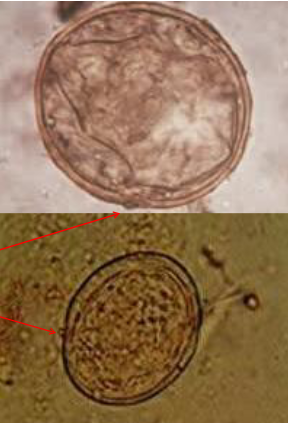
schistosoma haematobium
Bladder fluke
Adults mature in the liver
Migrate to venus plexus of bladder
Deposit ova in bladder wall
Eggs penetrate bladder wall to enter the urine
Complications
Granulomas and pseudo-abscesses
Fibrosis & calcification
Bladder cancer
schistosoma haematobium egg
112-180 x 40-70 um
Oval
Prominent terminal spine
Note developing embryo
Usually found in urine

food-borne trematodiasis
Infection occurs through consumption of contaminated freshwater fish, frogs, shellfish, snails, tadpoles, snakes, water plants, and other aquatic products eaten raw/insufficiently washed cooked
Endemic areas based on presence of intermediate hosts
Worldwide incidence:
Clonorchis sinensis → 35 million
Over ½ are Chinese
Paragonimus spp. → 20 million
Fasciola spp. → 2.4-17 million
Intestinal flukes (Fasciolopsis) → 40-50 million
non-blood trematodes
includes everything else but the schistosomes
Hermaphroditic (has both male and female organs)
Flat & leaf-like with ventral suckers
Divided by where adults live in the human body
Live in intestine / liver / lungs
Have operculated eggs
(non-blood trematodes) clinical manifestations
Adults do not replicate in the human host
Morbidity is associated with the worm burden and the infection intensity
Eggs / grams of feces
Inflammatory lesions and damage of tissues and target organs occurs
Damage related to worm burden
Complications such as cholangiocarcinoma (colon cancer)
(non-blood trematodes) human & economic impact
Humans: long term, chronic, debilitating diseases
Economic: loss of meat and milk products due to livestock infection
Household pets: can be a source of infection and economic burden (treatment costs) to owners
(non-blood trematodes) general life cycle
have complex life cycles
Aquatic snails are intermediate hosts
Up to 6 larval stages
Alternative sexual and asexual reproduction between life cycle stages

(non-blood trematode life cycle) eggs relase from adult
Into sputum--for Paragonimus sp
Into feces for everyone else
Large number of eggs produced per day
Clonorchis sinensis: 1,000-4,000/day for at least 6 months
Fasciolopsis buski: 16,000/day
Eggs are passed unembryonated
Need ideal environmental conditions to embryonate
Temperature (air & water), moisture, humidity
eggs are operculated
(non-blood trematode life cycle) miracidium
Eggs hatch into miracidium
Sac-like larvae
Attracted by chemotaxis and chemokines to the snails
Ingested by snail or penetrate snail skin by boring
Remain in snail for several weeks passing through various stages
Sporocyst, rediae, embryos, cercariae
(non-blood trematode life cycle) second intermediate host
Young fish (have thinner skin) living in stagnant or slow-moving freshwater
Highest density of parasite is found in the muscle
Encysted form is the metacercariae
Take 1 hour to several months to become infective
Depends on the species
(non-blood trematode life cycle) definitive host
Humans, sheep, cattle, pig, donkeys, beaver, deer, elk, and rabbits/hare
Ingest raw, undercooked, or pickled aquatic products
Gastric juices help with encystation
Immature adult released
Migrates to target organ and matures
Long life span
(non-blood trematode life cycle) co-infection and reinfection
Individuals can be infected with multiple trematode species
Occurs when endemic areas overlap
Reinfection occurs rapidly after treatment unless environment issues are addressed
(non blood trematodes) fasciolopsis buski
Giant intestinal fluke—lives in small intestine
Largest adult fluke
Endemic area: Asia, China, India, Indonesia, Taiwan, Thailand, Vietnam
Reservoir host: dogs, pigs, rabbits
Intermediate host: snail and fish
fasciolopsis buski egg
Hard to distinguish between Fasciola hepatica eggs
150 x 80 um
Ovoid, yellow-brown staining
Thin, smooth shell
Usually, an indistinct operculum
Unembryonated, material extends to shell margin
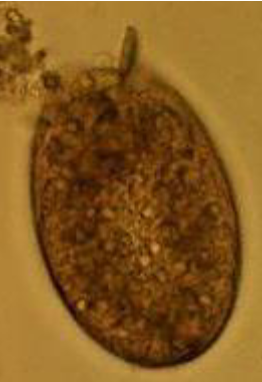
fasciolopsis buski life cycle
unembryonated eggs passed in feces
embryonate in water
miracida hatch & penetrate snail
undergoes numerous developmental stages
cercariae (terror tadpole) releases from snail
metacercariae encysts on water plants
water plants ingested by pigs/humans
encyst in duodenum of humans
adults live in small intestine
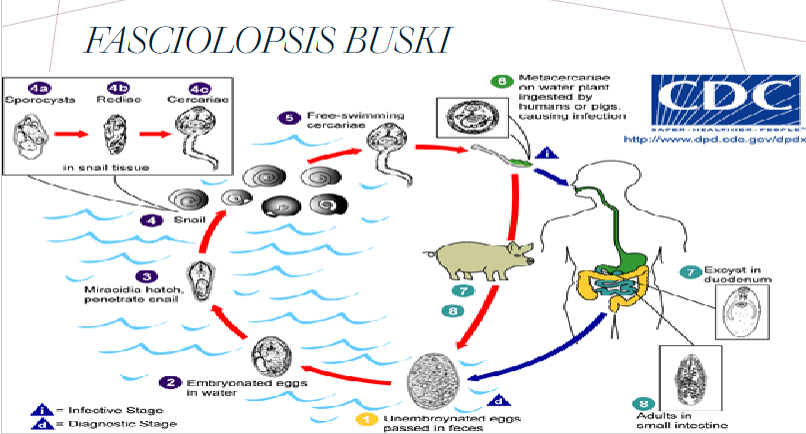
(non blood trematodes) fasciola hepatica
AKA sheep liver fluke
Worldwide distribution
Reservoir: herbivores
Cattle, sheep, goats etc
Eggs are identical to Fasciolopsis buski
Adults live in small intestine
fasciola hepatica egg
very large ; 120-159 um x 80-85 um
looks like F buski; hard to differentiate
operculum present
thin shelled
ovoid & yellow/brown
unembryonated

fasciola hepatica life cycle
same life cycle as Fasciolopsis buski except for reservoir host (cattle)
unembryonated eggs pass in feces
embryonate in water
miracidia hatch & penetrate snail
develops into multiple stages in snail
metacercariae release from snail
metacercariae lives on water plants (2nd int host) & are ingested by cattle, sheep or humans
metacercariae encysts in duodenem
metacercariae to adult takes 3-4 months
adults live in hepatic biliary ducts
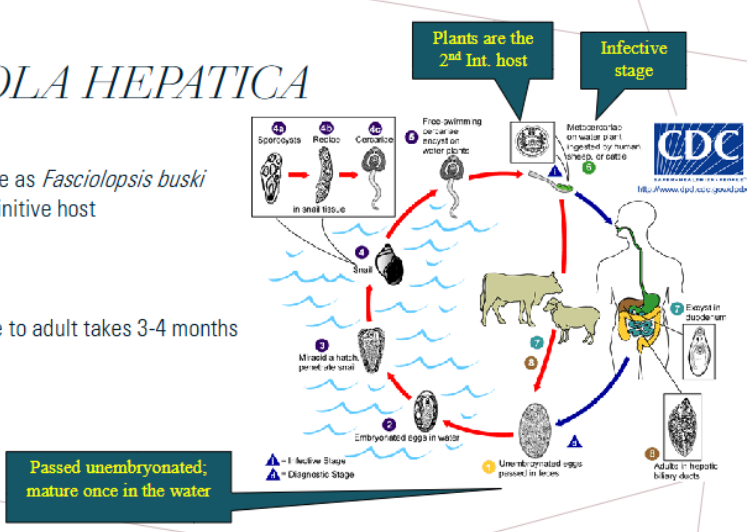
fasciola infections
Adult worm live in larger bile ducts of liver and gall bladder
Causes these symptoms:
Inflammation
Fibrosis
Blockage
Colic pain
Jaundice
Eventually liver cirrhosis
(non blood trematodes) Heterophyes heterophyes & Metagonimus yokogawai
Live in crypts of small intestine
Asia, Egypt, Turkey, Far east
Reservoir host: pigs, deer, mice, rats
No intestinal symptoms unless infection is heavy
Usually, self-limiting infection
Must be able to differentiate Clonorchis & Opisthorchis
Analyze both eggs and adult worms
Heterophyes heterophyes & Metagonimus yokogawai egg
27-35 x 14-16 um
Urn shaped
Seated/shoulder operculum
Small knob on aboperculum end
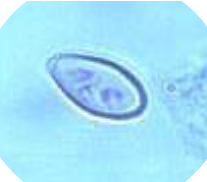
how to differentiate F buski and F hepatica?
need adult flukes to differentiate genera!!
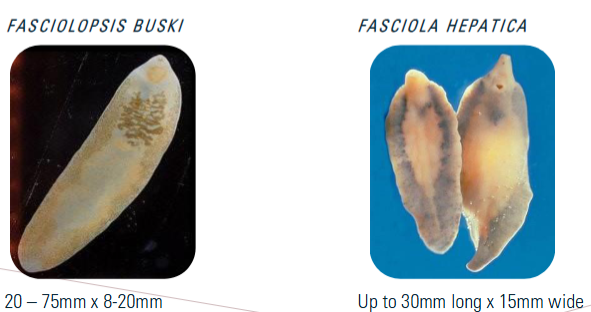
(non blood trematodes) clonorchis sinensis & opisthorchis sp
aka oriental or Chinese liver fluke
Found across Asian continent
Reservoir: Dogs, cats, other fish-eating mammals
Symptoms vary with worm burden
These organisms are considered carcinogens
Bile duct cancer (cholangiocarcinoma)
clonorchis sinensis & opisthorchis sp egg
27-35 um x 11-20 um
Shouldered operculum & abopercular knob
Embryonated
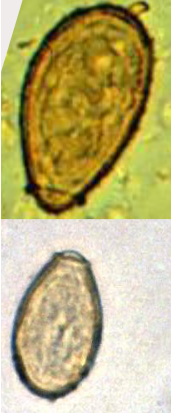
clonorchis sinensis life cycle
embryonated eggs pass in feces
eggs ingested by snail (intermediate host)
evolve into multiple stages in snail
miracidia → sporocysts → rediae → cercariae
free-swimming cercariae encyst in skin/flesh of freshwater fish
metacercariae in flesh or skin of freshwater fish ingested by definitive host
2nd int host; metacercariae in fish is infective stage
excyst in duodenum (human)
adults live in biliary duct of definitive host
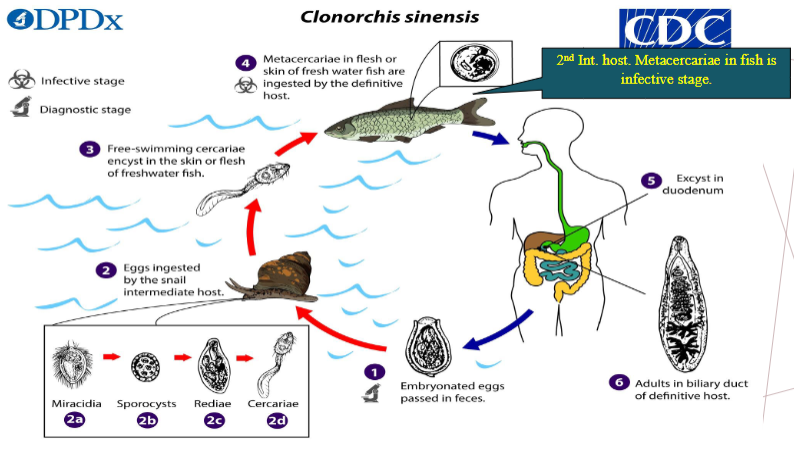
clonorchis & opisthorchis infections
Adult flukes live in the smaller bile ducts of the liver
Symptoms:
Inflammation
Fibrosis
Non-specific gastrointestinal symptoms
Chronic infection can lead to cholangiocarcinoma
Bile duct cancer
(non blood trematodes) paragonimus sp
Lung flukes…cough
Worldwide distribution but species have specific endemic areas
Second intermediate host: crustaceans (crayfish/crawdads, crabs, snails)
Reservoir host: dogs & cats
Eggs found in sputum and sometimes feces
Host coughs them up and swallows them
Disease can be confused with TB
species of paragonimus
>40 different species
Primary pathogenic species:
P westermani—most common; primarily in Asia
P africanus—Western & Central Africa
P mexicanus
Central & South America
What we have in lab!
P kellicotti
North America
Well known pathogen of wild & domestic animals
paragonimus sp life cycle
unembryonated eggs pass in sputum
embryonate in water
miracidia hatch and penetrate snail
miracidia → cercariae (3-5 mo)
cercariae invade crustacean and encyst into metacercariae
cercariae → metacercariae takes 6-8 wks
humans ingest inadequately cooked or pickled crustaceans containing metacercariae
humans pass eggs in sputum / feces
encyst in duodenum but migrate to lungs; mature adults take 5-6 wks
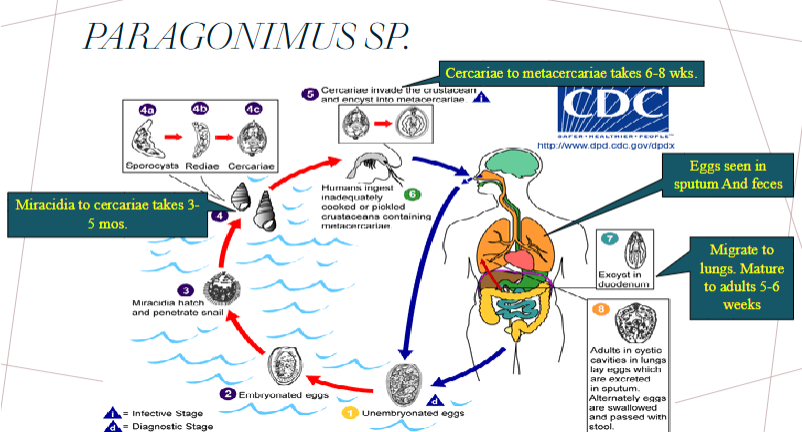
paragonimus infections
Symptoms
During larval migration--fever, malaise, diarrhea, epigastric pain
Once in lungs: pleuritic chest pain, pleural effusions (contain eosinophils), pneumothorax
Chest pain, dyspnea, cough, malaise
Chronic infections--mature adults in the lungs
Lung inflammation and fibrosis
Chocolate colored sputum
No fever or peripheral eosinophilia
paragonimus sp egg
All species have basically same morphology
80-120 x 48-60 um
Shaped like a chicken egg
Dark yellow brown
Thick smooth shell
Prominent shouldered operculum
Thickening of abopercular end
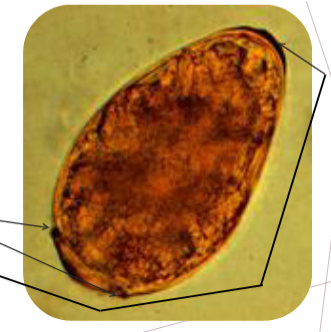
paragonimus kellicotti
2008 – 2017 13 cases in Missouri
6 more cases elsewhere in the Mississippi drainage basin
2017 – 3 cases of eosinophilic encephalitis reported in Missouri
Patients had consumed raw crayfish from streams and rivers
Only 7 cases reported in entire USA through 2007
All in the Midwest
paragonimus kellicotti egg
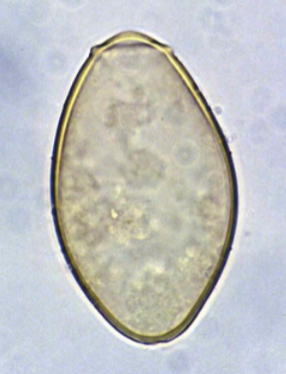
paragonimus kellicotti life cycle (pic)

how do we diagnose trematode infections?'
direct exam diagnosis
immunodiagnosis
molecular methods
(diagnosing trematode infections) direct exam diagnosis
Look for eggs in stool, sputum, or other body fluids
AKA ova and parasite exam
Limitations:
Low numbers of eggs released
Difficulty in speciating with just eggs, sometimes need an adult worm to entirely sure (Fasciolopsis buski & Fasciola hepatica!!!)
(diagnosing trematode infections) immunodiagnosis
Indirect diagnosis
Intradermal tests
Indirect hemagglutination assays
Indirect fluorescent antibody tests
Indirect EIA tests
No really good tests
A lot of cross reactivity
Intradermal test remain positive years after successful treatment
(diagnosing trematode infections) molecular methods
PCR based methods look for DNA of eggs in fecal sample
Very sensitive and specific
Expensive & need lots of resources
Used by US military
Complementary tools
Ultrasound
CT scan
MRI
answer the following about s mansoni / japonicum:
What form is shed/acquired from the human?
If, an egg, is it embryonated or not?
If it is a larvae, what kind of larvae?
What hatches from the egg?
egg is shed from the human; humans acquire by direct skin penetration
embryonated
n/a
miracidia (s mansoni)
answer the following about s mansoni / japonicum:
intermediate host? reservoir host?
What is the infective stage that gets back into the human?
How does the infective stage get back into the human?
General info about what happens once it gets back into the human.
Where do adults live?
intermediate: snail ; reservoir: water buffalo / pigs/dogs /cats/rodents
infective stage: cercariae
direct skin penetration
cercariae become schistomulae and migrate to liver
adults (paired worms) live in mesenteric venules of bowel/rectum
answer the following about s haematobium:
What form is shed/acquired from the human?
If, an egg, is it embryonated or not?
If it is a larvae, what kind of larvae?
What hatches from the egg?
embryonated egg ; no larvae
miracidium hatches from egg
(s haematobium)
answer the following about s haematobium:
intermediate host? reservoir host?
What is the infective stage that gets back into the human?
How does the infective stage get back into the human?
General info about what happens once it gets back into the human.
Where do adults live?
intermediate host: snail ; reservoir: none
infective stage: cercariae
direct skin penetration
cercariae → schistomulae → portal blood in liver
adults → venous plexus of bladder
answer the following abt f buski:
What form is shed/acquired from the human?
If, an egg, is it embryonated or not?
If it is a larvae, what kind of larvae?
What hatches from the egg?
unembryonated egg shed in feces ; no larvae
miracidia hatch from egg
answer the following abt f buski:
intermediate host? reservoir host?
What is the infective stage that gets back into the human?
How does the infective stage get back into the human?
General info about what happens once it gets back into the human.
Where do adults live?
intermediate: snail ; reservoir: pigs
infective stage: cercariae (terror tadpole) / metacercariae
humans ingest water plants w metacercariae
excyst in duodenum
adults: small intestine
answer the following about f hepatica:
What form is shed/acquired from the human?
If, an egg, is it embryonated or not?
If it is a larvae, what kind of larvae?
What hatches from the egg?
unembryonated eggs passed in feces ; no larvae
miracidia hatch from egg (f hepatica)
answer the followng abt f hepatica:
intermediate host? reservoir host?
What is the infective stage that gets back into the human?
How does the infective stage get back into the human?
General info about what happens once it gets back into the human.
Where do adults live?
intermediate: snail & water plants ; reservoir: cattle/sheep
infective stage: cercariae / metacercariae
humans eat contaminated water plants
excyst in duodenum
adults: hepatic biliary ducts
answer the following abt c sinensis:
What form is shed/acquired from the human?
If, an egg, is it embryonated or not?
If it is a larvae, what kind of larvae?
What hatches from the egg?
embryonated eggs passed in feces ; no larvae
eggs ingested by snail and then hatch into miracidia → sporocysts → rediae → cercariae (c sinensis)
answer the following abt c sinensis:
intermediate host? reservoir host?
What is the infective stage that gets back into the human?
How does the infective stage get back into the human?
General info about what happens once it gets back into the human.
Where do adults live?
intermediate host: snail & freshwater fish ; reservoir: dogs/cats, fish-eating mammals
infective stage: metacercariae in fish
humans eat freshwater fish contamined w the parasite
excyst in duodenum
adults: biliary duct
answer the following abt paragonimus sp:
What form is shed/acquired from the human?
If, an egg, is it embryonated or not?
If it is a larvae, what kind of larvae?
What hatches from the egg?
unembryonated eggs in feces/sputum ; no larvae
miracidia hatch from eggs (paragonimus)
answer the following abt paragonimus sp:
intermediate host? reservoir host?
What is the infective stage that gets back into the human?
How does the infective stage get back into the human?
General info about what happens once it gets back into the human.
Where do adults live?
intermediate host: snails/crustaceans ; reservoir: dogs/cats
infective stage: metacercariae
humans eat infected crustaceans w metacercariae
excyst in duodenum & travel to lungs to lay eggs
adults: lungs